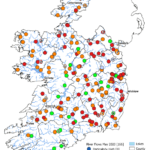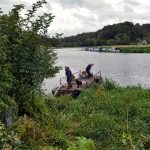The EPA runs a national hydrometric monitoring programme which measures…
EPA River, Lake and Marine monitoring – plain English factsheets
The EPA works with other public bodies in Ireland to monitor our rivers, lakes and marine waters. Plain English fact sheets highlighting this work were recently updated by the EPA and the latest version of each is below.
River Monitoring
Biological monitoring has been carried out in Irish rivers since 1971. The current national river monitoring programme covers more than 13,000 km of river channel.
The national monitoring programme is run by the EPA and focuses on the main river channels rather than the smaller streams. The programme includes more than 2,800 sites sampled for biology, with almost half of these being sampled for physical and chemical parameters.

Lake Monitoring
A total of 225 lakes are currently included as part of the national surface waters monitoring programme run by the EPA, this covers around 80% of the surface area of all lakes in Ireland. This includes:
- all lakes greater than 50 hectares
- lakes that are used for supplying drinking water
- lakes that are of regional, local or scientific interest

Lake Monitoring – Aquatic Plants
Aquatic plants are good at showing if the quality of the water is good or bad and play an important role in lake ecology by providing food and a habitat for many smaller plants, animals and birds. They also:
- provide shelter for young fish
- help to improve the clarity of the water
- help stabilise lake shore banks
- reduce the amount of sediment being suspended in the water
The Environmental Protection Agency (EPA) monitors these aquatic plants at more than 10,000 sites in over 200 lakes once every three years.

Marine Monitoring
Ecologically healthy marine waters are a valuable natural resource. They support a rich and diverse range of ecosystems, habitats and species, and they are also a source of food – from wild fisheries and aquaculture. They are also important for recreational activities and tourism. Transitional and coastal waters are assessed under the European Water Framework Directive (WFD) and the Marine Strategy Framework Directive (MSFD).
Having coordinated frameworks for water quality for all the water bodies in Ireland, and across Europe, allows us to compare our results with other countries. It allows us to see what works to help us make sure all our water bodies achieve at least ‘good’ status, and no deterioration occurs.

Marine Monitoring – Phytoplankton
Phytoplankton are tiny, free-floating plants found suspended in the world’s oceans. Their name comes from Greek and means ‘plant drifter’. They are carried along by ocean currents and are usually found floating near the surface of the water. Like all plants they need sunlight to grow. The main sources of nutrients around Ireland’s coast are discharges from wastewater treatment plants and run off from agricultural land.
The Environmental Protection Agency (EPA) and the Marine Institute monitor phytoplankton to assess the quality (status) of our marine environment. They must do this as part of the requirements of the European Water Framework Directive.
The EPA and the Marine Institute sample phytoplankton in estuaries and coastal waters around Ireland. They carry out sampling three times during the summer and once during winter. At each location, they take water samples just below the surface and above the seabed. They use the samples to assess how much phytoplankton is in the water and what species are present.

Learn more:
These fact sheets and EPA water quality reports can be downloaded from the EPA website.







